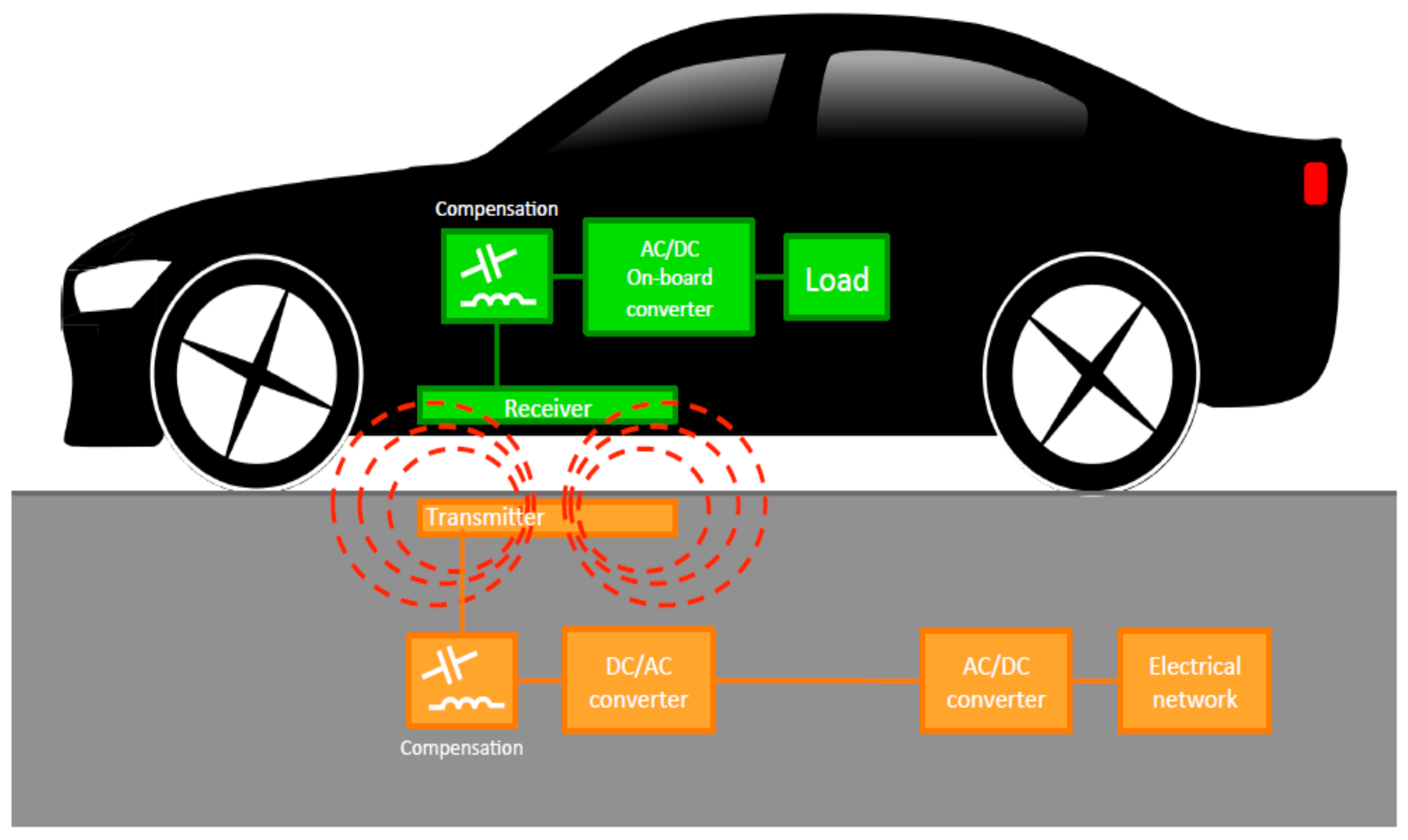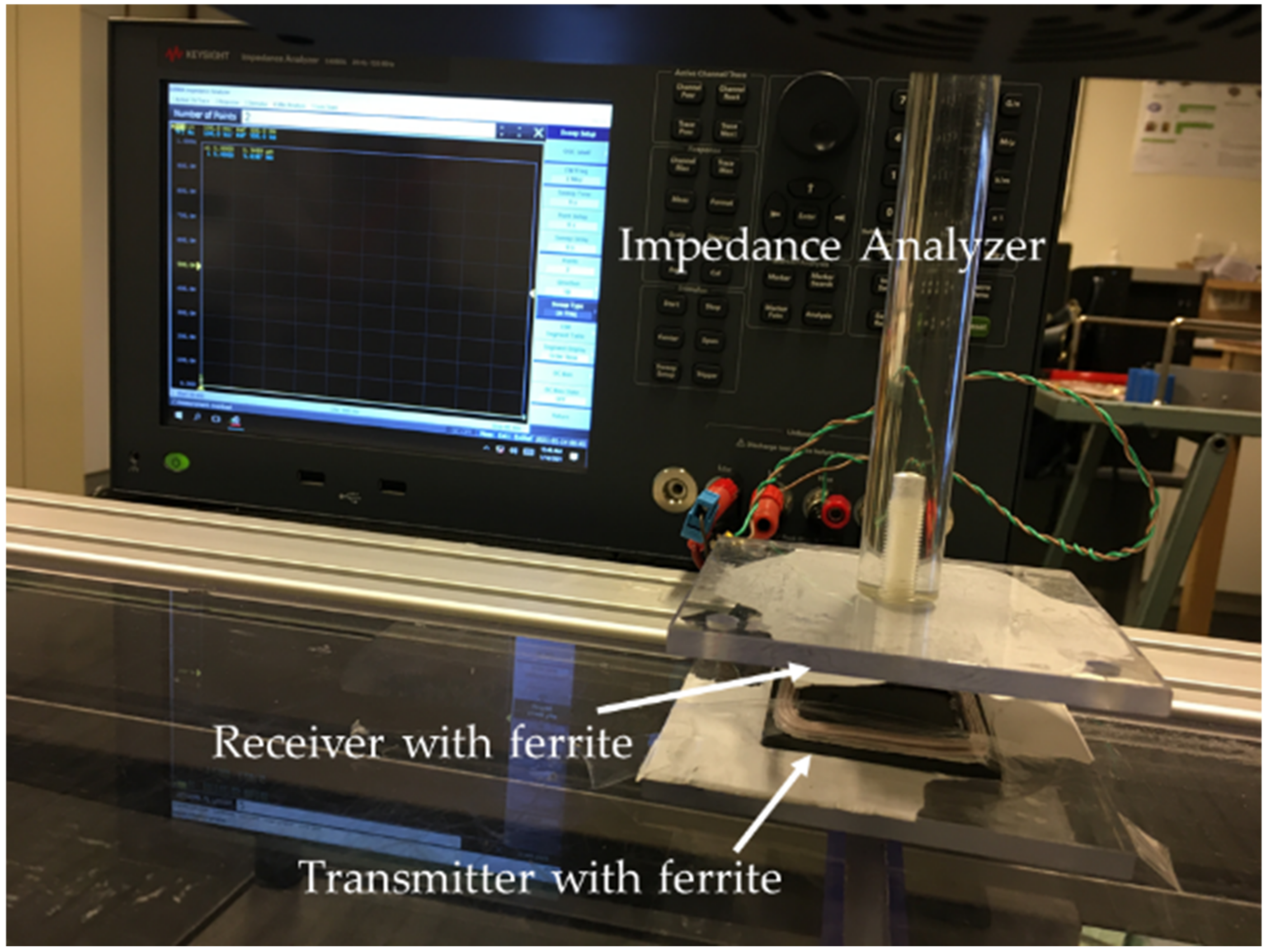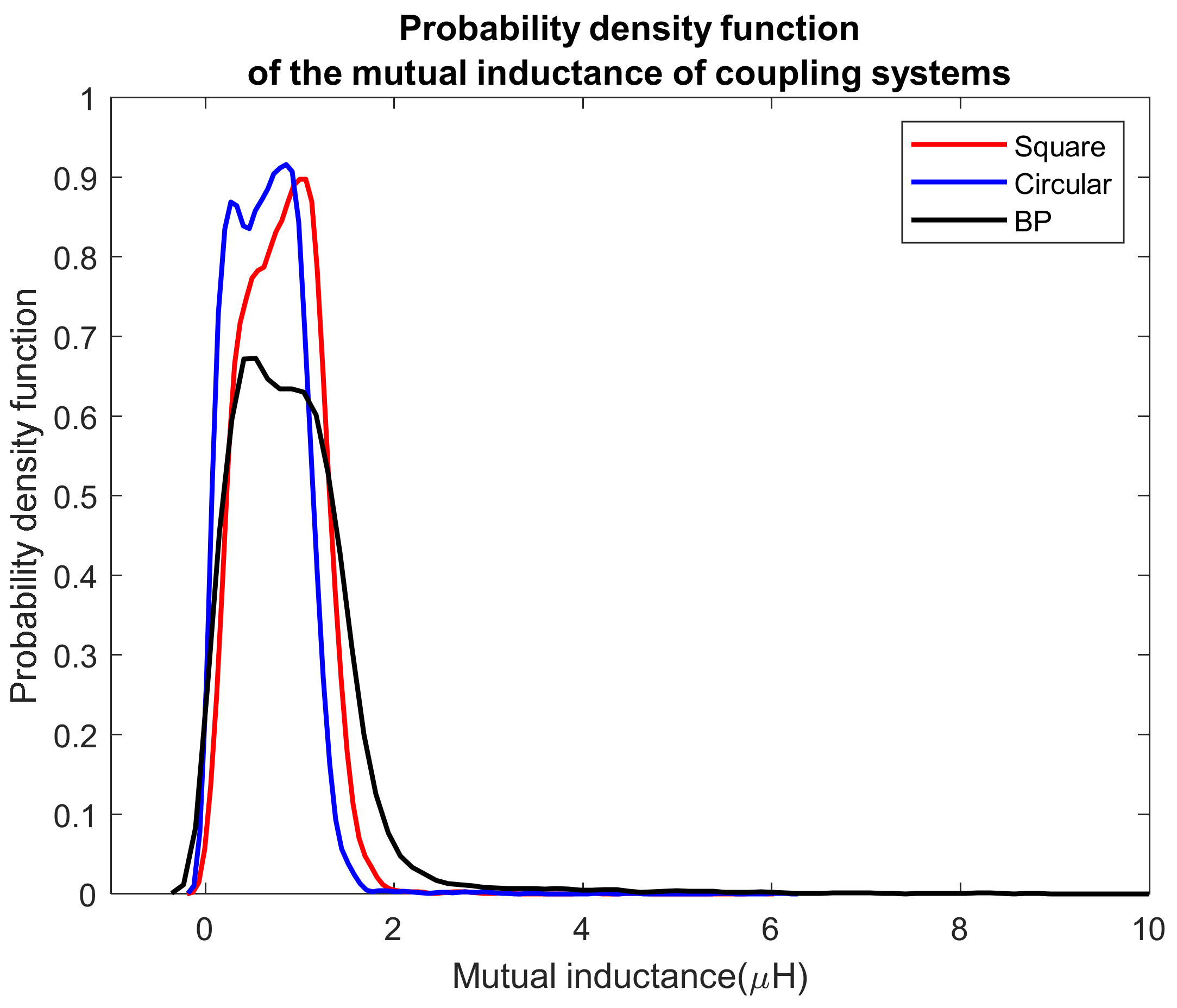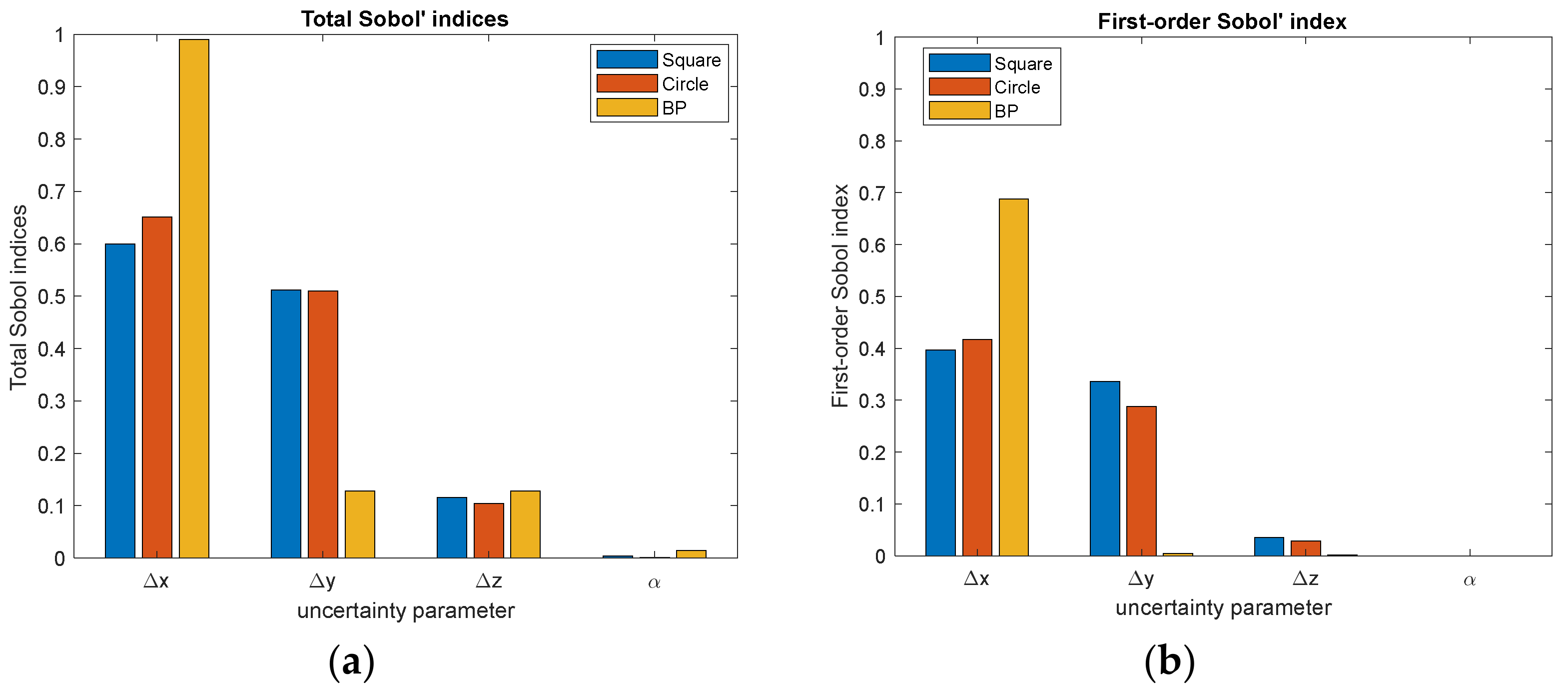Comparison of Coupling Coils for Static Inductive Power-Transfer Systems Taking into Account Sources of Uncertainty
Abstract
:1. Introduction
2. Static Inductive Power Transfer Systems
2.1. Coil Geometry in SIPT System
2.2. Methodology to Calculate the Maximum Transmission Efficiency
3. Mutual Inductance Metamodeling for SIPT Systems
3.1. Sources of Uncertainty in the SIPT System
3.2. General Description of Sparse Polynomial Chaos Expansion
3.3. Numerical Analysis
4. Sensitivity Analysis
5. Comparison and Discussion
6. Conclusions
Author Contributions
Funding
Institutional Review Board Statement
Informed Consent Statement
Data Availability Statement
Conflicts of Interest
References
- Clairand, J.-M.; Guerra-Terán, P.; Serrano-Guerrero, X.; González-Rodríguez, M.; Escrivá-Escrivá, G. Electric Vehicles for Public Transportation in Power Systems: A Review of Methodologies. Energies 2019, 12, 3114. [Google Scholar] [CrossRef] [Green Version]
- Zhang, B.; Carlson, R.B.; Smart, J.G.; Dufek, E.J.; Liaw, B. Challenges of future high power wireless power transfer for light-duty electric vehicles—Technology and risk management. eTransportation 2019, 2, 100012. [Google Scholar] [CrossRef]
- Cirimele, V.; Torchio, R.; Villa, J.L.; Freschi, F.; Alotto, P.; Codecasa, L.; Rienzo, L.D. Uncertainty Quantification for SAE J2954 Compliant Static Wireless Charge Components. IEEE Access 2020, 8, 171489–171501. [Google Scholar] [CrossRef]
- Liu, C.; Jiang, C.; Qiu, C. Overview of coil designs for wireless charging of electric vehicle. In Proceedings of the 2017 IEEE PELS Workshop on Emerging Technologies: Wireless Power Transfer (WoW), Chongqing, China, 20–22 May 2017; pp. 1–6. [Google Scholar]
- Villa, J.L.; Sallán, J.; Llombart, A.; Sanz, J.F. Design of a high frequency Inductively Coupled Power Transfer system for electric vehicle battery charge. Appl. Energy 2009, 86, 355–363. [Google Scholar] [CrossRef]
- Azad, A.N.; Echols, A.; Kulyukin, V.A.; Zane, R.; Pantic, Z. Analysis, Optimization, and Demonstration of a Vehicular Detection System Intended for Dynamic Wireless Charging Applications. IEEE Trans. Transp. Electrif. 2019, 5, 147–161. [Google Scholar] [CrossRef]
- Wireless Power Transfer for Electric Vehicles and Mobile Devices|Wiley. Available online: https://www.wiley.com/en-au/Wireless+Power+Transfer+for+Electric+Vehicles+and+Mobile+Devices-p-9781119329053 (accessed on 15 May 2021).
- Cabrera, A.T.; González, J.M.G.; Sánchez, J.A.A. Wireless Power Transfer for Electric Vehicles: Foundations and Design Approach; Power Systems; Springer: Berlin/Heidelberg, Germany, 2020; ISBN 9783030267056. [Google Scholar]
- Yang, Y.; Cui, J.; Cui, X. Design and Analysis of Magnetic Coils for Optimizing the Coupling Coefficient in an Electric Vehicle Wireless Power Transfer System. Energies 2020, 13, 4143. [Google Scholar] [CrossRef]
- Knaisch, K.; Gratzfeld, P. Comparison of magnetic couplers for inductive electric vehicle charging using accurate numerical simulation and statistical methods. In Proceedings of the 2015 5th International Electric Drives Production Conference (EDPC), Nuremberg, Germany, 15–16 September 2015. [Google Scholar]
- Prasanth, V.; Bandyopadhyay, S.; Bauer, P.; Ferreira, J.A. Analysis and comparison of multi-coil inductive power transfer systems. In Proceedings of the 2016 IEEE International Power Electronics and Motion Control Conference (PEMC), Varna, Bulgaria, 25–28 September 2016; pp. 993–999. [Google Scholar]
- Olukotun, B.; Partridge, J.S.; Bucknall, R.W.G. Optimal Finite Element Modelling and 3-D Parametric Analysis of Strong Coupled Resonant Coils for Bidirectional Wireless Power Transfer. In Proceedings of the 2018 53rd International Universities Power Engineering Conference (UPEC), Glasgow, UK, 4–7 September 2018; pp. 1–6. [Google Scholar]
- Nayak, P.S.R.; Kishan, D. Design and analysis of SS resonant IPT system with computed mutual inductance through FEM model. In Proceedings of the 2018 International Conference on Power, Instrumentation, Control and Computing (PICC), Thrissur, Kerala, 18–20 January 2018; pp. 1–5. [Google Scholar]
- Capua, G.D.; Femia, N.; Stoyka, K.; Mambro, G.D.; Maffucci, A.; Ventre, S.; Villone, F. Mutual Inductance Behavioral Modeling for Wireless Power Transfer System Coils. IEEE Trans. Ind. Electron. 2021, 68, 2196–2206. [Google Scholar] [CrossRef]
- Panchal, C.; Stegen, S.; Lu, J. Review of static and dynamic wireless electric vehicle charging system. Eng. Sci. Technol. Int. J. 2018, 21, 922–937. [Google Scholar] [CrossRef]
- Knaisch, K.; Gratzfeld, P. Gaussian process surrogate model for the design of circular, planar coils used in inductive power transfer for electric vehicles. IET Power Electron. 2016, 9, 2786–2794. [Google Scholar] [CrossRef]
- Pei, Y.; Pichon, L.; Bensetti, M.; Le Bihan, Y. Uncertainty quantification in the design of wireless power transfer systems. Open Phys. 2020, 18, 391–396. [Google Scholar] [CrossRef]
- Trinchero, R.; Larbi, M.; Torun, H.M.; Canavero, F.G.; Swaminathan, M. Machine Learning and Uncertainty Quantification for Surrogate Models of Integrated Devices with a Large Number of Parameters. IEEE Access 2019, 7, 4056–4066. [Google Scholar] [CrossRef]
- COMSOL Multiphysics, Stockholm, Sweden. Introduction to COMSOL Multiphysics. Available online: https://www.comsol.com/documentation/IntroductionToCOMSOLMultiphysics.pdf (accessed on 1 October 2019).
- Cirimele, V. Design and Integration of a Dynamic IPT System for Automotive Applications. Ph.D. Thesis, Université Paris Saclay, Gif-sur-Yvette, France, Politecnico di Torino, Torino, Italy, 2017. [Google Scholar]
- Batra, T. Design of Static Wireless Charging System for Electric Vehicles with Focus on Magnetic Coupling and Emissions. Ph.D. Thesis, Department of Energy Technology, Aalborg University, Aalborg, Denmark, 2015. [Google Scholar]
- J2954: Wireless Power Transfer for Light-Duty Plug-in/Electric Vehicles and Alignment Methodology—SAE International. Available online: https://www.sae.org/standards/content/j2954_202010/ (accessed on 26 March 2021).
- Kadem, K. Modeling and Optimization of a Magnetic Coupler for Electric Vehicles Dynamic Induction Charging. Ph.D. Thesis, Université Paris Saclay, Gif-sur-Yvette, France, 2020. [Google Scholar]
- Bosshard, R.; Mühlethaler, J.; Kolar, J.W.; Stevanović, I. Optimized magnetic design for inductive power transfer coils. In Proceedings of the 2013 Twenty-Eighth Annual IEEE Applied Power Electronics Conference and Exposition (APEC), Long Beach, CA, USA, 17–21 March 2013; pp. 1812–1819. [Google Scholar]
- Robert, W.E.; Dragan, M. Fundamentals of Power Electronics, 2nd ed.; Springer: New York, NY, USA, 2001. [Google Scholar]
- Larbi, M.; Stievano, I.S.; Canavero, F.G.; Besnier, P. Variability Impact of Many Design Parameters: The Case of a Realistic Electronic Link. IEEE Trans. Electromagn. Compat. 2018, 60, 34–41. [Google Scholar] [CrossRef]
- Marelli, S.; Sudret, B. UQLab User Manual—Polynomial Chaos Expansions; Report UQLab-V1.3-104; Chair of Risk, Safety and Uncertainty Quantification, ETH Zurich: Zurich, Switzerland, 2019. [Google Scholar]
- Blatman, G.; Sudret, B. Adaptive sparse polynomial chaos expansion based on least angle regression. J. Comput. Phys. 2011, 230, 2345–2367. [Google Scholar] [CrossRef]
- Least Angle Regression. Available online: https://arxiv.org/abs/math/0406456 (accessed on 25 March 2021).
- Marelli, S.; Sudret, B. UQLab: A Framework for Uncertainty Quantification in Matlab. In Vulnerability, Uncertainty, and Risk. Quantification, Mitigation, and Management, Proceedingsof the 2nd International Conference on Vulnerability, Risk Analysis and Management (ICVRAM 2014) & 6th International Symposium on Uncertainty, Modeling, and Analysis (ISUMA 2014), Liverpool, UK, July 13–16 2014; ETH Zurich: Zurich, Switzerland, 2014; pp. 2554–2563. [Google Scholar] [CrossRef] [Green Version]
- Lataniotis, C.; Marelli, S.; Sudret, B. UQLab User Manual—The INPUT Module; Report UQLab-V0.9-102; Chair of Risk, Safety and Uncertainty Quantification, ETH Zurich: Zurich, Switzerland, 2019. [Google Scholar]








| Coil Shape | M(µH) FEM Simulation | M(µH) Experimental Values | Relative Error of Simulation (%) |
|---|---|---|---|
| Square | 1.36 | 1.32 | 2.69% |
| Circle | 1.17 | 1.13 | 3.46% |
| BP | 1.54 | 1.39 | 9.63% |
| Parameters | Symbol | Distribution | Mean Value | Standard Deviation |
|---|---|---|---|---|
| Misalignment along the X axis [mm] | Gaussian | 0 | 15 | |
| Misalignment along the Y axis [mm] | Gaussian | 0 | 15 | |
| Air gap between two coils [mm] | Gaussian | 15 | 2 | |
| Rotation angle along the Z axis [deg] | Gaussian | 0 | 3 |
| Coil Shape | Samples to Build the PCE Metamodel | LOO Error (%) |
|---|---|---|
| Circle | 55 | 0.42% |
| Square | 55 | 0.29% |
| BP | 55 | 3.53% |
| Parameters | Symbol | Distribution | Mean Value | Standard Deviation |
|---|---|---|---|---|
| Misalignment along the X axis [mm] | Gaussian | 0 | 2/5/10 | |
| Misalignment along the Y axis [mm] | Gaussian | 0 | 2/5/10 |
| Coil Shape | Length [cm] | [µH] | Ratio
[cm/µH] | Maximum Transmission Efficiency % |
|---|---|---|---|---|
| Square | 93.1 | 1.36 | 68.5 | 95.4% |
| Circle | 73.1 | 1.17 | 62.5 | 95.8% |
| BP | 139.9 | 1.54 | 90.8 | 93.9% |
| PCE Metamodel | Coil Shape | Mean Value of M E[M] [µH] | Standard Deviation of M [µH] | Mean Value of Ratio [cm/µH] | Mean Value of Maximum Transmission Efficiency % |
|---|---|---|---|---|---|
| Square | 0.811 | 0.404 | 115 | 92.3% | |
| Circle | 0.645 | 0.389 | 113 | 92.4% | |
| BP | 0.926 | 0.787 | 151 | 89.9% |
Publisher’s Note: MDPI stays neutral with regard to jurisdictional claims in published maps and institutional affiliations. |
© 2021 by the authors. Licensee MDPI, Basel, Switzerland. This article is an open access article distributed under the terms and conditions of the Creative Commons Attribution (CC BY) license (https://creativecommons.org/licenses/by/4.0/).
Share and Cite
Pei, Y.; Le Bihan, Y.; Bensetti, M.; Pichon, L. Comparison of Coupling Coils for Static Inductive Power-Transfer Systems Taking into Account Sources of Uncertainty. Sustainability 2021, 13, 6324. https://doi.org/10.3390/su13116324
Pei Y, Le Bihan Y, Bensetti M, Pichon L. Comparison of Coupling Coils for Static Inductive Power-Transfer Systems Taking into Account Sources of Uncertainty. Sustainability. 2021; 13(11):6324. https://doi.org/10.3390/su13116324
Chicago/Turabian StylePei, Yao, Yann Le Bihan, Mohamed Bensetti, and Lionel Pichon. 2021. "Comparison of Coupling Coils for Static Inductive Power-Transfer Systems Taking into Account Sources of Uncertainty" Sustainability 13, no. 11: 6324. https://doi.org/10.3390/su13116324








